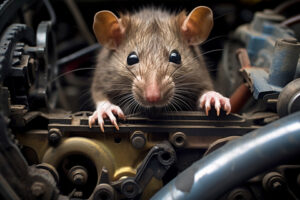How to protect your car from rodents!
November 8, 2024
Rodent damage to vehicles is a well-established and prevalent problem. Rats’ biology requires them to constantly chew so their teeth don’t grow too long. Vehicles are attractive as a source of readily available nesting materials and chewing materials. Sometimes, food debris in the car will also attract the rats. Vehicles stored over the winter or driven less frequently are at higher risk.
When rodents take up residence and begin chewing on wiring, power steering lines, hoses, plastic, and other critical car parts, they can cause electrical issues, fluid leaks, and even outright engine failure. The problems can be severe, ranging from clogging the air filters and conditioning ducts with rodent nesting materials to damaging the engine wiring harness, which can cost thousands of dollars to replace. People have even had their engine intakes filled with acorns.
- Ideally, park away from places known to draw rodents, such as near trash bins or natural food sources, like vegetable gardens.
- Park in a sealed garage, if possible, and keep the doors closed.
- Make sure the garage doesn’t have stored food and prime nest materials like newspapers, cardboard, straw, rags, and patio furniture cushions.
- Look for gaps around garage windows and doors for places where rodents can sneak in. Weather strips under side doors can help seal them. Likewise, inspect the vertical seals on retractable garage doors for damage.
- Don’t store trash cans used for food waste in the garage.
- Keep the car interior free from food wrappers; their scent can draw rodents.
- Regularly vacuum and clean if you allow children to eat or snack in the vehicle
- Move the car regularly to discourage varmints from taking up residence. Occasionally, honk the horn before starting the car to scare away napping critters.
What else can you do?
CR’s Car Repair Assistant
Get estimates on repair work from certified local shops.
How to Get Rid of Furry Vermin
There are specially-made spray products designed to deter rodents. If the vehicle is garaged, you could mist one of these products under the hood and around the vehicle. Peppermint oil and cayenne pepper are also reported to deter rodents. Note that spray products will need to be reapplied routinely because they can wear away and rinse off.
There are ultrasonic devices that emit sounds to deter rodents, but at a frequency that humans can’t hear. However, little data exists on whether these devices actually repel rodents or are effective in rodent control.
For vehicle storage, placing mothballs under the hood can help. (Don’t use them inside the car, or you’ll be stuck with that awful smell.)
Honda offers a clever solution: rodent-deterrent tape. This tape is essentially an electrical tape treated with super-spicy capsaicin, which Honda describes as “the stuff that puts the fire in a bowl of five-alarm chili.” The tape (part No. 4019-2317) comes in a 20-meter roll, about 22 yards, and it is available through dealers and online for around $40.
Other suggestions for dealing with rodents under your hood include installing metal mesh around wiring harnesses and rubber hoses and across any openings where rodents could crawl into your ventilation or intake systems.
Placing rodent traps around the garage can reduce the population. Please be careful when exposing children, domestic animals, and birds of prey like owls, eagles, and hawks to poisons. Poisons can cause lasting damage to bird populations.
If the rodents are winning the war despite following these tips, contact a local pest control service. They are trained to combat stubborn rodent issues and can address your specific challenges.
Your auto policy may provide some coverage for rodent damages if you carry comprehensive coverage on your vehicle. However, due to the prevalence of these claims, some carriers have altered policy wording to exclude rodent damage from being covered. So you will want to check your policy wording or check with your agent if you have questions.